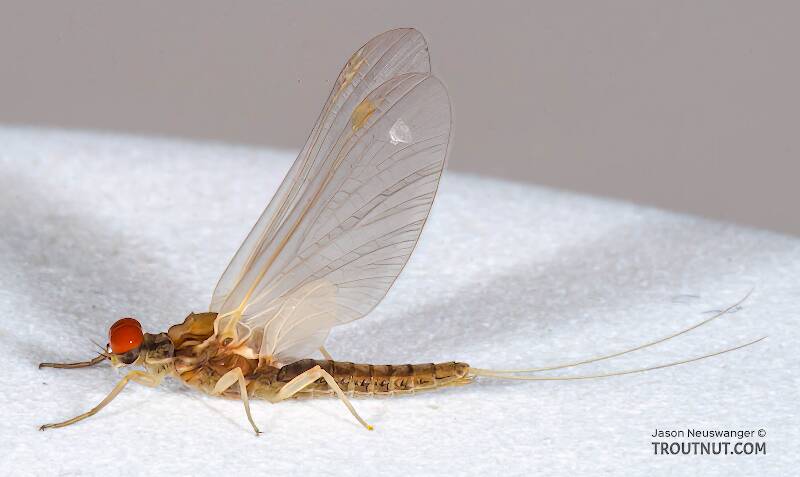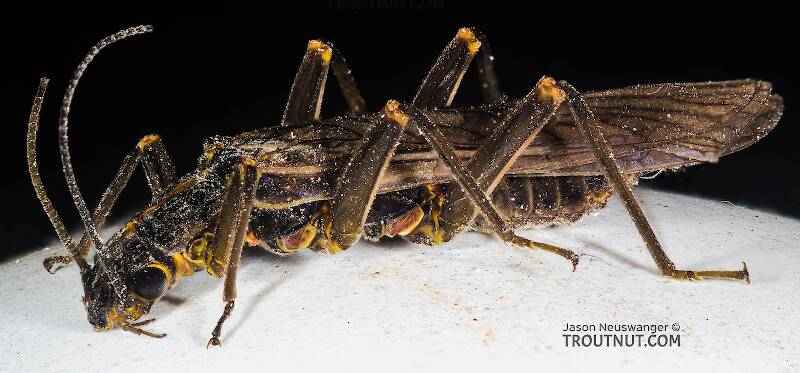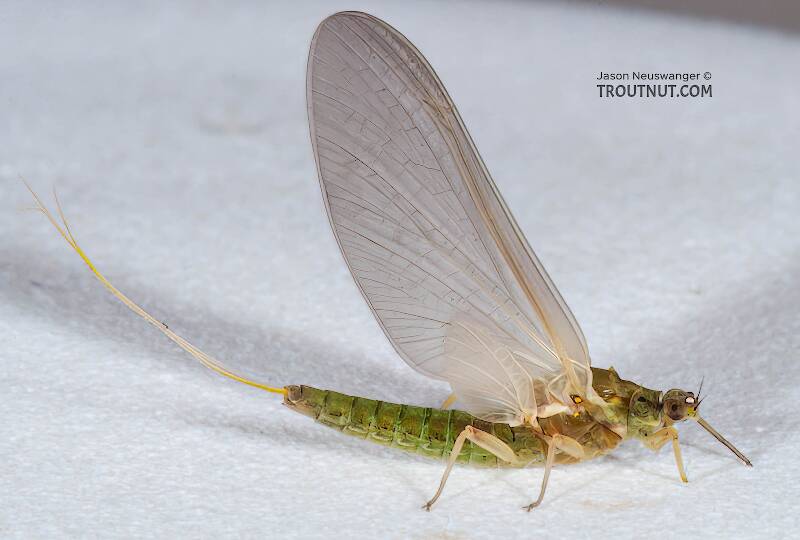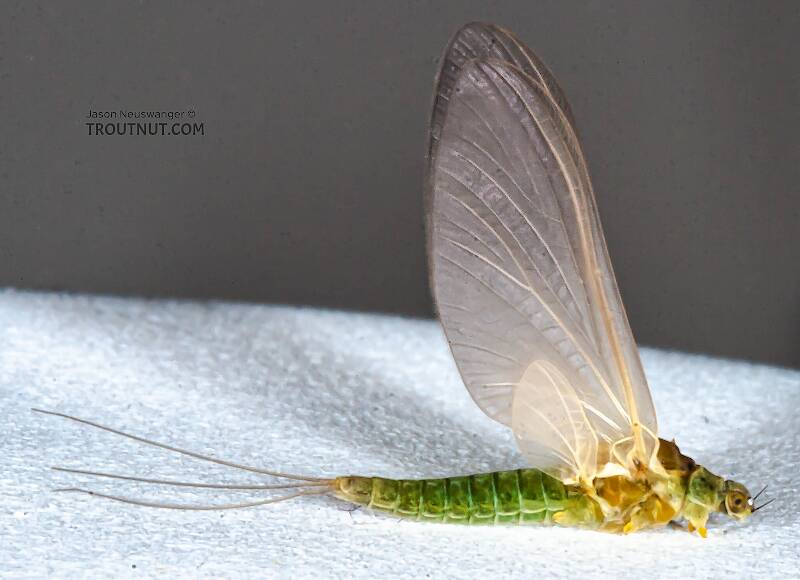
Blue-winged Olives
Baetis
Tiny Baetis mayflies are perhaps the most commonly encountered and imitated by anglers on all American trout streams due to their great abundance, widespread distribution, and trout-friendly emergence habits.

Mayfly Species Attenella attenuata (Blue-Winged Olives)
I have several specimens listed under this species, but I'm not positive the identification is correct.
Where & when
This species begins to emerge in Pennsylvania in early June, and good hatches last through early July in the Catskills. In the Upper Midwest it continues into August.In 15 records from GBIF, adults of this species have been collected during July (60%), June (13%), August (13%), May (7%), and April (7%).
In 2 records from GBIF, this species has been collected at elevations of 194 and 1909 ft.
Species Range
Hatching behavior
Just like Drunella mayflies, Attenella attenuata duns rapidly change color after emerging. They start out bright green and fade into a dull medium olive color. Anglers should imitate the initial color.
This species produces a high number of cripples.
Spinner behavior
Time of day: Dusk
Habitat: Riffles
Their spinner falls can provide good action, especially since they're found at a time of year when little else is on the water. The specimens I photographed belong to a hatch whose spinners produced good dusk rises for me several times late one July.
Nymph biology
Current speed: Slow to medium
Physical description
Most physical descriptions on Troutnut are direct or slightly edited quotes from the original scientific sources describing or updating the species, although there may be errors in copying them to this website. Such descriptions aren't always definitive, because species often turn out to be more variable than the original describers observed. In some cases, only a single specimen was described! However, they are useful starting points.
Male Spinner
Wing length: 6 mm
A species considered to be of the simplex (now a synonym of Dannella simplex) group; fore tarsus of male comparatively short, third joint of forceps long, about one-half the length of the second.
Eyes deep brown. Head and thorax deep blackish brown. Legs pale yellowish white; fore legs darker, the tibia and tarsus largely smoky. The middle and hind femora may show an apical brownish spot. Fore tibia about one and one-half times the length of the femur, and about as long as the entire tarsus. Hind tibia twice as long as the tarsus. Wings hyaline; venation hyaline, cross veins faint except in the stigmatic area, where they are strongly anastomosed. Abdomen dark brown dorsally, the three posterior segments paler brown. Paler ventrally, the eighth sternite quite pale creamy brown. Forceps whitish, shaded at base with light brown; third joint very long, about one half the length of the second. Penes united except for a slight V-shaped apical cleft; widened apically, narrowed again at the extreme apex (see fig. 157). Tails white.
Nymph
Nymph rather slender; abdomen somewhat flattened. Occipital and prothoracic tubercles present, also a single median anterior and a similar posterior mesothoracic tubercle. The lateral extensions of the abdominal segments are prolonged into shorter and blunter postero-lateral spines than in E. simplex (now a synonym of Dannella simplex); the lateral margin of segment 8 is distinctly and characteristically sinuate. Dorsal spines are present, most distinct on segments 4-7. Gills present on segments 4-7 only. General color light brown. A few blackish spots are present on the anterior portions of the pronota and mesonota, and one dark spot near the base of the wing pads. Legs slender, pale; each femur is marked with a narrow broken median dark band; tibia with a median black ring, and a broader black band at the base of the tarsus. 8 to 9 denticles on each claw. Pale submedian dorsal stripes may be present, also a median dark streak on the apical tergites; on the anterior margins of the first five tergites are lateral pale dots; the lateral extensions are pale, with a median brown band. Ventrally a lateral row of dark dashes is present on each side, a curved row of four small dark dots across each sternite, and sometimes dark median blotches on the anterior margin of each. Tails rather short, pale in immature nymphs, with a dark band before the apex; in mature nymphs the tails are reddish at the base, and may be crossed by two dark bands beyond the middle. Basally they bear short spines; apically each is fringed with long fine hairs.
Specimens of the Mayfly Species Attenella attenuata
1 Male Dun

2 Female Duns
Start a Discussion of Attenella attenuata
References
- Arbona, Fred Jr. 1989. Mayflies, the Angler, and the Trout. Nick Lyons Books.
- Caucci, Al and Nastasi, Bob. 2004. Hatches II. The Lyons Press.
- Fauceglia, Ted. 2005. Mayflies . Stackpole Books.
- Knopp, Malcolm and Robert Cormier. 1997. Mayflies: An Angler's Study of Trout Water Ephemeroptera . The Lyons Press.
- Needham, James G., Jay R. Traver, and Yin-Chi Hsu. 1935. The Biology of Mayflies. Comstock Publishing Company, Inc.
- Schwiebert, Ernest G. 1955. Matching the Hatch. MacMillan Publishing Company.
- Swisher, Doug and Carl Richards. 2000. Selective Trout. The Lyons Press.
Mayfly Species Attenella attenuata (Blue-Winged Olives)
Species Range
Common Names
Resources
- NatureServe
- Integrated Taxonomic Information System
- Global Biodiversity Information Facility
- Described by McDunnough (1925)




